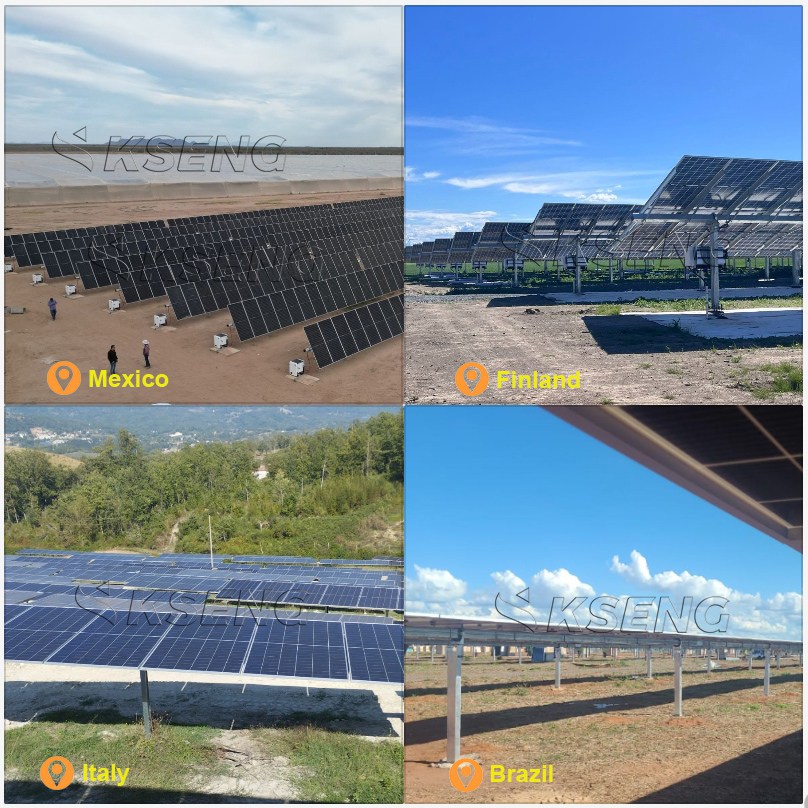Kseng single-axis solar tracking mounting system is a solar photovoltaic mounting technology that allows solar panels to move along a single axis (usually east-west) in order to track the sun's trajectory, thereby increasing the efficiency of solar energy collection.
Brand:
KsengProduct Origin:
ChinaShipping Port:
XiamenMaterial:
carbon steelDrive System:
Slewing DriveTracking Range:
±45°to ±60°Tracking Accuracy:
±1°

Kseng KST-1P solar bracket is designed with a tracking mechanism that follow the position of the sun as it moves from east to west. Single axis tracker can increase production between 25% to 35%.
Adopt single-slew-drive, KST-1P allows for large tracking range between ±60°, it's a relatively cost-effective solution with high stability.


Materials
205PCS/MW (Estimated with 600W PV-Modules)
Structure Parameters
System type
One Portrait Horizontal single-axis tracking system
Maximum capacity per row
54KWp (Estimated with 600W PV -Modules)
PV-Modules quantity per row
90 PCS (1Px90)
Tracking range
±60°
Tracking accuracy
±1°
HDG Steel, Al-Mg-Zn Coating
Steel
Foundation
Concrete foundation, Steel
pile, PHC pile
Quantity of foundation/MW
|
Controller Parameters |
|
|
Controller system |
MCU |
|
Tracking method |
Astronomical
algorithm+closed-loop control (AI) |
|
Signal transmission |
Wire (RS485) or wireless (Zig bee) |
|
Drive method |
Slew drive |
|
Motor type |
DC 24V |
|
Power supply |
AC-powered or self-powered |
|
Foundation |
Concrete foundation, Steel
pile, PHC pile |
Advanced AI tracking algorithm
AI self-learning algorithm to optimize the angular deviation caused by terrain and bracket installation errors. Compared with the traditional tracking algorithm, the power generation of the power station can be increased by 2%-3%.

KST-1P features
1:Cost-effective, stable & efficient system
2:Fully fit for 210 module
3:Al algorithm to maximize power generation
4:Adapt to various terrains allowing a north-south slope up to 20%
5:Easy installation & maintenance
Terrain adaptability
1. Flexible arrangement, make full use of irregular land and can improve land utilization.
2. North and South can adapt to 20% slope.
3. Unlimited slope in the east-west.

What is single axis solar tracking?
1.Single-axis solar tracking system is a technique used to orient solar panels or solar collectors towards the sun's position throughout the day. Unlike fixed solar arrays that remain in a fixed position, single-axis trackers allow the solar panels to move either horizontally (azimuth) or vertically (elevation) to maximize their exposure to sunlight.
2.Single-axis solar trackers typically use a motorized system to adjust the position of the solar panels in response to the movement of the sun. The tracker can be programmed to follow the sun's trajectory from east to west, maximizing the amount of sunlight captured by the solar panels.
3.Horizontal single-axis automatic solar tracking system rotate the panels around a fixed horizontal axis, typically aligned in the north-south direction. The panels rotate from east to west, keeping the panels perpendicular to the sun's rays as it moves across the sky.
4.Vertical single-axis solar panel tracking system rotate the panels around a fixed vertical axis, typically aligned in the east-west direction. The panels rotate from north to south, allowing them to track the sun's elevation angle. By adjusting their tilt angle throughout the day, the panels can maintain an optimal angle relative to the sun.
5.Single-axis sun tracking solar system offer several advantages compared to fixed solar arrays. By tracking the sun's movement, they can significantly increase the solar panels' energy output, typically by 20% to 40%, depending on the location. This helps to maximize the efficiency of the solar panels and increase the overall energy generation.
Related Tags :